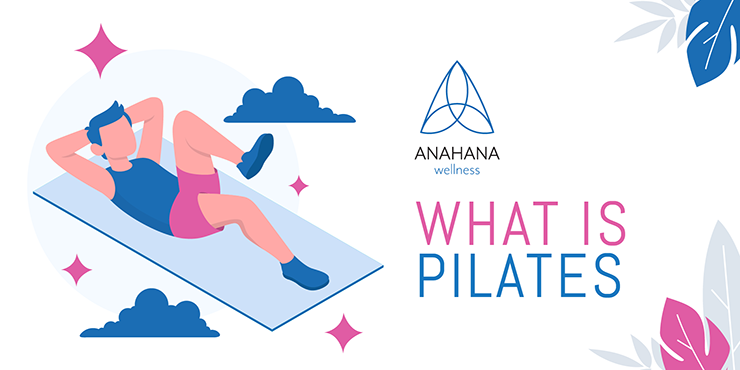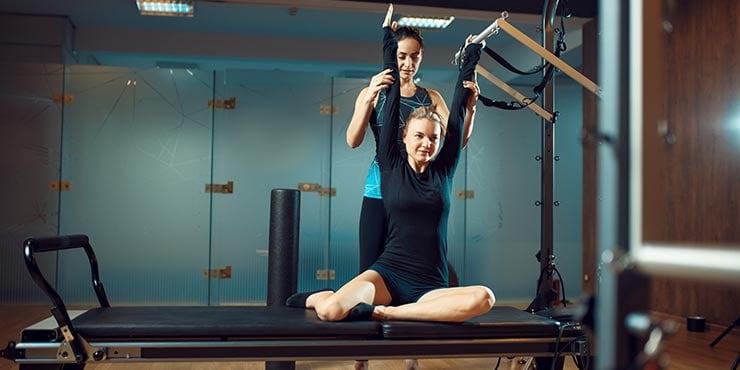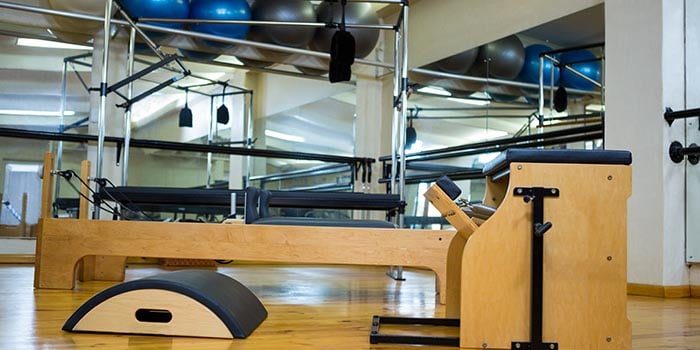Pilates
The Pilates method is the practice of low-impact mind body exercise that aims to strengthen muscles while improving posture and flexibility. Pilates...
Pilates is a form of resistance training that originated in Germany. Joseph Pilates created it in the 1920s for rehabilitation for war soldiers, and since then, it continues to be used by people around the world due to its extensive benefits. These include increased flexibility, strength, and concentration. In recent years, Pilates has become one of the most well-known and popular forms of exercise and is now the choice of training for numerous celebrities, including Madonna, Russel Brand, Kate Hudson, and many others.
 Due to the Covid-19 pandemic, society has had to find a different form of exercise that is accessible from home and requires minimal equipment. Pilates is just that as it only requires a mat and a screen to access Pilates videos. These fitness classes provide great exercises for getting into shape. The Pilates industry has never been as popular as it is now, and with this increased following has come an increase in demand for Pilates instructors.
Due to the Covid-19 pandemic, society has had to find a different form of exercise that is accessible from home and requires minimal equipment. Pilates is just that as it only requires a mat and a screen to access Pilates videos. These fitness classes provide great exercises for getting into shape. The Pilates industry has never been as popular as it is now, and with this increased following has come an increase in demand for Pilates instructors.
With Pilates fitness teachers in high demand, many people are making a career change to the teaching practice. The first step in this career is Pilates instructor training. It will be a commitment mentally, physically, financially, and time-wise. If an individual dedicates themself to the practice, it will pay off. Continue reading to learn more about teacher training certification programs and what to expect while completing a teacher training program.
Most programs will ask an individual to meet specific requirements before registering for the course. This often includes movement experience in sports, dance, or yoga. In addition, other programs will ask students to take a certain number of private classes with an instructor involved in the training program. To find teacher training programs in the area, reach out to a local instructor.
Pilates studios will often have teacher training programs. This allows them to be able to hire instructors that have completed a comprehensive program at their studio. By doing this, they know exactly what the coursework studied during the comprehensive training program includes and what style of class the individual will teach.
Once the teacher training program is finished and a Pilates certification is obtained, learning will continue throughout an individual's career through workshops and classes. Continuing education is important to be a good Pilates instructor. It strengthens an individual's knowledge and helps further their career. In addition, many Pilates teachers have the goal of completing their Pilates Method Alliance (PMA) certification once they are established teaching. This alliance governs the body of the world of Pilates. Before registering for any program, be aware that teacher training program is a significant commitment and should be taken seriously.
Joining the Pilates industry and becoming a Pilates instructor is a great career choice. It is challenging, constantly evolving, and highly rewarding. The first step to becoming a Pilates instructor is to decide precisely what type of Pilates teacher to become. There are two types of Pilates certifications: a mat certification and a comprehensive certification.
The first option is to complete a mat certification and become a mat instructor. These instructors teach classical Pilates at local facilities. Classical Pilates classes are performed on a mat and include exercises that improve core strength, such as planks. These Pilates exercises help practitioners build muscle strength, tone, and endurance. Teaching Pilates with a mat certification is limited making it hard to make a living off of. This training program is a great option for those looking to teach Pilates as a part-time job.
The other option is to obtain a comprehensive certification. A comprehensive program will prepare future Pilates teachers to instruct students using traditional Pilates equipment, including a chair, trapeze table, Cadillac, reformer, and more. If the goal when completing a Pilates certification program is to teach full-time to large groups, in private training sessions, or through personal training, a comprehensive program is the way to go.
Before choosing a teacher training program to register for, an individual must determine why they want to complete a training program. This answer will help narrow down which teacher training program is most appropriate. Factors affecting different Pilates certifications include training (such as any prerequisites required), cost (payment plans are often available), level, and commitment. If the goal is to teach mat classes at a local fitness center, a mat certification is required. A comprehensive certification is required for those completing the training program to become a full-time Pilates instructor or for those wanting to work at a Pilates studio.
Training programs are often divided into classical Pilates and contemporary Pilates. Classical Pilates training teaches the original Pilates method developed by Joseph Pilates and Clara Pilates. On the other hand, contemporary Pilates training teaches a broad range of exercises with an emphasis on rehabilitation. Its foundations are still rooted in the original Pilates method created by Joseph Pilates, but it is a more up-to-date version of Pilates using scientific research to guide its methods.
The most suitable program will vary depending on the individual's interests and goals. Here is a list of some of the well-known pilates certification programs that are worth looking into:
Stott Pilates: Stott Pilates certified instructors are well regarded and recognized throughout the Pilates industry, making it a great course. They teach contemporary Pilates at essential, intermediate, and advanced levels. They also provide courses that focus on teaching the use of a specific prop such as a reformer, Cadillac, chair, or barrel. It is suitable for beginner or experienced instructors and can help further their careers.
Balanced Body: Balanced Body teaches classical Pilates. This method from Joseph Pilates includes the repertoire, movement principles, class design, and client-specific applications of each exercise. They have many course options, including mat instructor training, reformer instructor training, comprehensive training, or a combination of mat and reformer training. They also provide training programs for rehabilitation professionals such as physical therapists. Balanced Body can provide someone with all the skills they need to be a good Pilates instructor.
Fletcher: This is one of the most comprehensive international Pilates educational programs. It derives from the traditional Pilates methods developed by Joseph and Clara Pilates and expands to include its evolution and interpretation by first-generation Pilates teacher Ron Fletcher. They also provide bridging options for those who have completed training through a different eligible program previously.
Basi: Basi offers a mat program, comprehensive program, advanced educational studies, and more. Due to the wide range of training program options available, there are Pilates certifications appropriate for those from beginner to advanced levels. For those participating in these teacher training courses, it will be important to secure continuing education credits from the Pilates Method Alliance (PMA). Basi programs are available in more than 30 countries with over 100 locations.
Equinox: This is one of the newest Pilates instructor programs available. They have both comprehensive Pilates instructor training and mat certification courses. The comprehensive program combines virtual and in-person training, whereas the mat certification can be completed virtually.
Club Pilates Teacher Training: This is an established comprehensive training program that provides a challenging and nurturing learning environment. The club Pilates teacher training program will prepare practitioners to become full-time Pilates instructors. While learning to master Pilates exercises, this program teaches about how the body functions and moves to help students with imbalances or injuries. The course materials are highly accessible through an online portal, allowing those taking the training to learn at their own pace.

Training programs will have practical work hours. This means hours where the student observes and learns exercises in a studio setting. This includes hours for observation, self-practice, and teaching practice as well as a final written exam and practical exam. During the training, students will also learn aspects of how the body works by focusing on breath work, core control, and postural alignment. There are two types of Pilates certifications available: a mat certification and a comprehensive certification.
The programs start with foundational mat work. Some teacher training programs will offer a stand-alone mat certification, while others will provide comprehensive training. A mat certification will use very little equipment. One piece of equipment that is sometimes used is a prop called a magic circle. This is a circular-shaped resistance prop that provides a variable amount of resistance to challenge practitioners as they perform mat work.
A mat certification course alone will consist of 150 to 180 hours of practice over six to twelve weeks. In addition, many schools will require both a written and practical final exam at the end of the course. A teaching apprenticeship is also completed, where the individual will practice teaching Pilates. These additional factors make a Pilates mat certification course a longer commitment than yoga. Still, it is in higher demand, so higher pay can be expected.
When taking a comprehensive training program, the course work will teach about using a mat, reformer, Cadillac, chair, ped-o-pul, barrels, and more for Pilates classes. In addition, there will be educational lessons on the human body and modifications for different populations. Whether taking a program on mat work alone or a comprehensive course, the Pilates courses will be divided into modules.
A comprehensive course is 500 to 600 hours over six months to one year. Once the course modules are complete, the written and practical examinations for the certification program must be completed within 12 months. Once the individual has passed the course, they will begin a teaching apprenticeship just as they would in a mat certification course. Here, they will practice teaching students. Due to the Covid-19 pandemic, there are many online options as well as in-person training programs. Most online courses will still require some in-person training especially to practice teaching. The amount of in-person training will vary depending on the course. Online training may not be ideal for all. Still, it has made Pilates instructor training programs more accessible than ever before as they can be completed from anywhere in the world.
Once the Pilates certification program has been completed, many studios will require a Pilates instructor to obtain their liability insurance. Whether the Pilates instructor owns a studio or works part-time at a local rec-center, this will be required.
Comprehensive Pilates insurance will cover commercial general liability insurance, professional liability insurance, and contents coverage. Pilates teachers must have this before they practice teaching. It will protect them and the studio they work at from any claims that the Pilates teacher or the studio caused any physical damage to the practitioner. For a full-time Pilates instructor, this typically costs between $500 and $1000 per year. This can be obtained online through many websites, including Pilates Method Alliance (PMA), Idea Fit, Lockton, and more.
The training is vigorous and can be a financial commitment. The cost can vary depending on where the individual studies and the level of certification they are obtaining. For someone only looking to receive a mat certification, it can cost as little as $100 to $300.
To become fully trained and receive the comprehensive Pilates certification, expect to spend at least $4000. Most programs have payment plans, which allow the option to pay for the certifications in several intervals. Keep in mind that there may be additional fees, reach out to the teacher training program before registering to ask questions.
There is no single best Pilates program, as the course best suited for you depends on your preferences and goals. Any program that allows you to achieve a comprehensive certification will help you achieve all your Pilates teacher goals. It is up to you to determine which one matches your interests the closest.
Many gyms and fitness centers ask for a level 3 Pilates certification. More specifically, the YMCA qualification. Therefore, this may be a good fit for those who want to teach Pilates part-time in a gym rather than full-time in a studio.
For those who love Pilates, aspire to grow their knowledge, and want to teach a Pilates practice themself or improve their self practice, then it is worth it. Becoming a certified Pilates instructor is not easy, and it will be a financial and mental commitment. It will take lots of hard work and dedication. Therefore, those who are not interested in becoming a Pilates instructor or gaining more Pilates experience may find teacher training is not for them. This is because they will have to commit themselves to the practice as well as improve their self practice during their free time for up to two years. For those willing to commit themselves to the course, teaching Pilates is a highly rewarding career choice. It can also lead to opportunities for someone to own their own studio.
To be fully certified with a comprehensive Pilates certification, a course that is 500-hours or longer will be required. This is significantly longer than completing a personal trainer program. This takes place in modules and can take anywhere from 12 months to 24 months to complete. Those who take comprehensive training have to dedicate themself to the practice. Therefore, they must make sure it is the career path for them before they commit themselves to the training. For individuals looking for a mat certification, this will take only 150 to 180 hours of training over six to twelve weeks. At the end of both the comprehensive and mat certification courses, there will be a written and practical examination to complete the Pilates program.
Yes, Pilates instructors are in demand throughout North America and Europe. In addition, people who teach Pilates often get paid even better wages than a personal trainer or yoga instructor. A full-time Pilates instructor, working 25 to 30 hours a week, can have a salary over $50,000. There has never been a better time to become a Pilates professional.
STOTT PILATES Teacher Certification - Instructor Training
STOTT PILATES - Comprehensive Program Certification | Merrithew™
Pilates Instructor Training | Balanced Body
Courses | PT/Rehab | Balanced Body
Comprehensive Program - Fletcher Pilates
Bridge Program - Fletcher Pilates
BASI Pilates Upcoming Programs
Pilates Teacher Training at Equinox

The Pilates method is the practice of low-impact mind body exercise that aims to strengthen muscles while improving posture and flexibility. Pilates...

Pilates is a form of resistance training that originated in Germany. Joseph Pilates created it in the 1920s for rehabilitation for war soldiers, and...

There is an extensive range of Pilates equipment on the market today. Some pieces include reformer boxes, Pilates sticks, rollers, and Pilates...